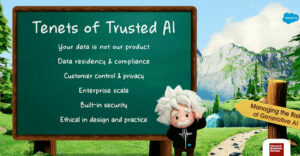
Dreamforce’s two-and-a-half hour keynote on Wednesday featured plenty of technology talk — the ability to add individual customers to Chatter, the use of HTML5 to create native-like mobile CRM applications, a scheme to allow customers to store some sensitive data in an on-premises location rather than within Salesforce’s data centers, and more. And technology is neat — don’t get me wrong. The art and science of managing customer relationships would be lost without it.
But one thing Salesforce CEO Marc Benioff said early on really stuck in my head. He said that the idea of a digital divide — a world of technology haves and have-nots — was no longer the issue. It was the idea of a social divide, between customers who behaved digitally and companies who did not.
Now, the idea of a social divide is somewhat specious — after all, businesses are run by people who are also customers themselves, so the idea is omnipresent, and business has been very conscious of moving to accommodate the social customer, with widely varying degrees of success. What I have an issue with is the idea that a digital divide is no longer an important issue. It still is an issue — and not just an issue of societal equity but one of business significance.
Which Customers Count?
Saying we’re now facing a social divide rather than a digital divide carries with it an implication that customers who are not social or who are at the very least connected to technology are no longer valuable customers to think about.
It’s very easy to imagine a executive rationalizing that if customers are not social, perhaps they no longer merit our focus or our concern; after all, if they’re not using social media like the majority of people, they’re likely to be less economically privileged and less likely to have significant buying power.
Don’t fall into this trap.
First off, our tendency to now focus on the social customer is not only driven by the engagement opportunities social media affords businesses, as great as they are. It’s also driven by the idea of data — customer-generated data and data that’s now readily available and “free” to use. This is a bit of business-centric thinking that, I think, is hurting the evolution of social CRM — the idea that a business can simply harvest data from social media, plug it into CRM, and then pretend it’s behaving in a social way. That requires a two-way conversation — but that itself is a different conversation than the one we’re having here.
My point is that businesses love data that’s easily collected about customers, and the internal thinking can very easily drift toward valuing customers you can easily collect information from over those you can’t. From a logical point of view, that may be true, but from an actual-dollars point of view, that may prove disastrous.
Second, the people on the wrong side of the digital divide fall into two groups: those economically underprivileged people who have traditionally been thought of when the term was used, and people who won’t or can’t use the technology for other reasons. There are a significant number of people over retirement age who have not embraced social media or even technology, and using social media as a gauge of their worthiness as customers is a terrible idea.
Where the Money Is
Did you know that people over 50 control 67 percent of the nation’s wealth, or that they have US$2.4 trillion in annual income (even counting many retirees among their number)?
If you sell broadly, and especially if you sold actively into this audience, why would you overlook members of this demographic simply because they don’t supply you with easily collected data?
Of course, Benioff didn’t expressly mean that the older audience and the less economically advantage audience should be overlooked — his philanthropic activities show he’s not inclined to act that way. But his statement is evidence of how easy it is to get caught up in technology at the expense of recognizing where the money is: with the customers, social or otherwise.























































